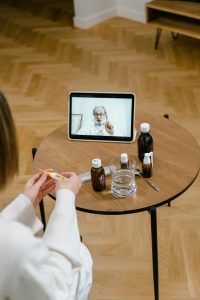Skip to content




Modern in-home caregiving technology is becoming more important for Oklahoma City home care in the treatment of older adults. Not every senior who needs help requires an in-home caregiver. Some may only require a check-in, medication reminder, or access to healthcare providers who can help answer questions or coordinate care.
Technology can also provide socialization for a senior living alone. It’s beneficial for coordinating team members who care for seniors, especially by including family members. Virtual care can fill the gaps and reduce the cost in the process, while giving family caregivers peace of mind.
People don’t have a physician who can take the time to listen.
Virtual care helps much like traditional medical care does. Unlike healthcare 60 years ago, when the doctor was often the only professional the patient dealt with unless they were in the hospital, today’s healthcare system has a specialist for every disease.
Primary care doctors frequently don’t have the time to ensure services don’t overlap or medication interactions don’t occur. Specialty care has overtaken primary care. Having someone to coordinate everything can prevent medical errors and reassure the patient and the family.
Using technology can help identify issues before they become serious.
Periodic check-ins are beneficial. Some people are reluctant to mention issues. They either don’t want to bother a doctor or don’t believe the problem is serious enough to warrant a doctor’s visit. They may decide to wait until their next check-up and forget to mention it or feel too rushed to bring it up. Virtual caregiving can help. They act proactively and ask questions that cover broad areas. The patient is in their own home, so the stress and rush of a doctor’s office are not factors.
Even having access to a home blood pressure machine or other tools for vital signs like heart rate and temperature can be beneficial for self reporting. A smart phone can provide medication reminders, for example. But, video conferencing and other mobile app technology has made it so easy to connect with a remote care professional nowadays, the added peace of mind and reassurance is worth the investment.
This is truly revolutionizing the home care industry, particularly for those individuals and families that want quality of care, but for whatever reason, aren’t ready to have a home care professional physically inside their home just yet.
In-home caregiving technology means remote care is always available.
Most health issues seem to occur late at night or on the weekend. It may not be serious enough for urgent care or an emergency room. That doesn’t mean they aren’t troubling. Remote care coordinators can provide reassurance and simple at-home techniques that help.
A virtual caregiver identifies when further evaluation is required to ensure seniors using in-home caregiving technology get the necessary care from healthcare professionals. Whether that’s through in-person visits to the doctor’s office or a trip to the emergency room.
- Loneliness can negatively contribute to existing conditions. It leads to depression, which causes a lack of activity and loss of appetite. Virtual care can provide activities that promote interaction to help prevent the problem.
- Many elderly people feel more comfortable telling a virtual service care provider about their issues than sharing them with family members. They often don’t want to burden family members with problems.
- Virtual care can include remote monitoring of safety with fall alert technology. Remote Care Monitors—RCMs—can detect a fall immediately 24/7. Every second counts when a fall occurs.
- Remote patient monitoring can identify when a senior left a door open, has started to wander, or has abnormal behavior. It’s a second set of eyes that are always available 24/7.
- Even wearable devices like an Apple Watch can help provide a high level of protection. The watch can notify emergency care professionals within 1 minute after it detects a fall.
The healthcare industry has evolved, and the standard for patient care has increased dramatically. The latest caregiving technological innovations and virtual care services are helping families and home healthcare agencies to meet that increased standard of care.
That’s why so many health care providers are recommending it to their patients. For more information, call us at (405) 461-6175 or contact us today at LiveBetter At Home.
